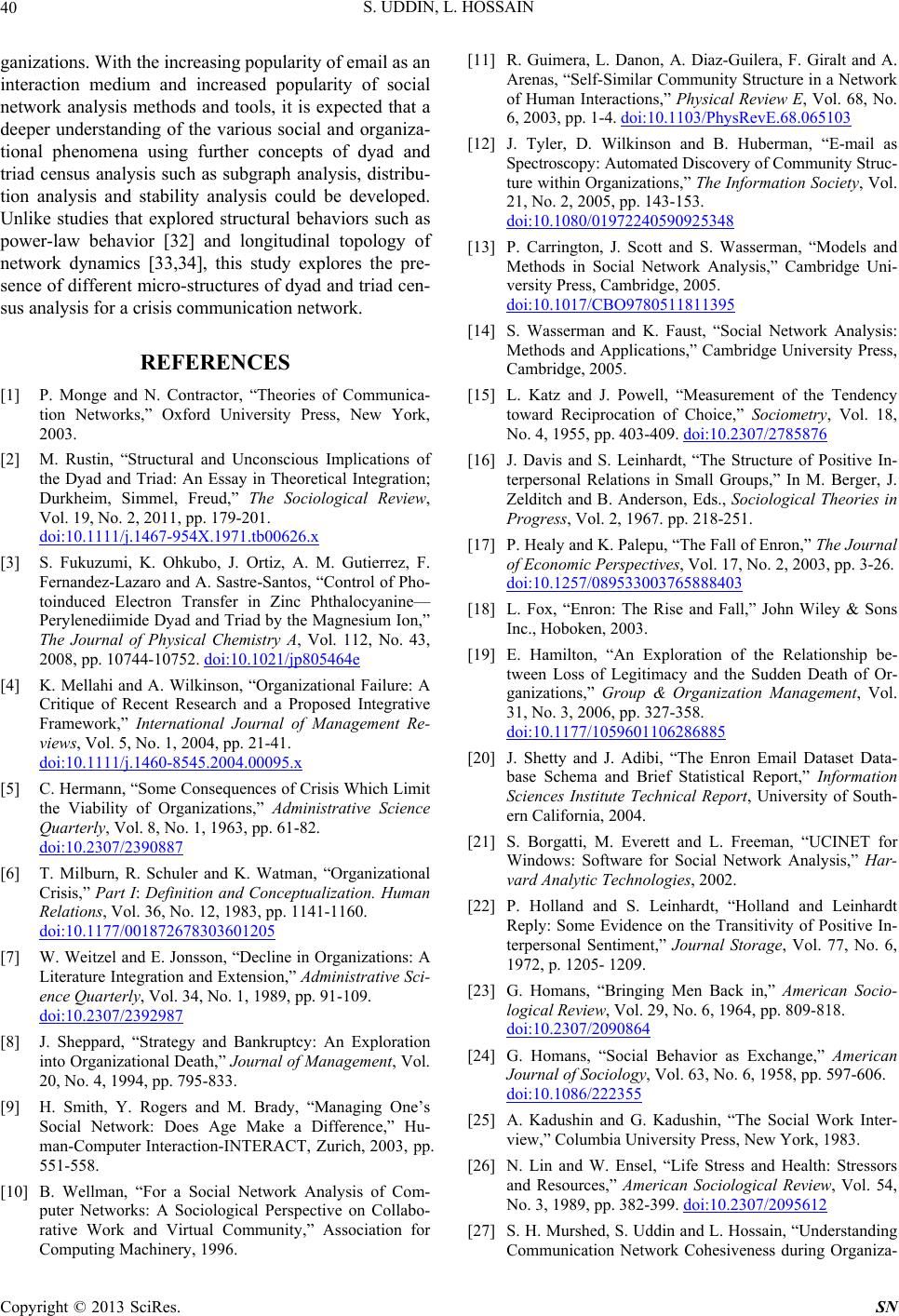
S. UDDIN, L. HOSSAIN
40
ganizations. With the increasing popularity of email as an
interaction medium and increased popularity of social
network analysis methods and tools, it is expected that a
deeper understanding of the various social and organiza-
tional phenomena using further concepts of dyad and
triad census analysis such as subgraph analysis, distribu-
tion analysis and stability analysis could be developed.
Unlike studies that explored structural behaviors such as
power-law behavior [32] and longitudinal topology of
network dynamics [33,34], this study explores the pre-
sence of different micro-structures of dyad and triad cen-
sus analysis for a crisis communication network.
REFERENCES
[1] P. Monge and N. Contractor, “Theories of Communica-
tion Networks,” Oxford University Press, New York,
2003.
[2] M. Rustin, “Structural and Unconscious Implications of
the Dyad and Triad: An Essay in Theoretical Integration;
Durkheim, Simmel, Freud,” The Sociological Review,
Vol. 19, No. 2, 2011, pp. 179-201.
doi:10.1111/j.1467-954X.1971.tb00626.x
[3] S. Fukuzumi, K. Ohkubo, J. Ortiz, A. M. Gutierrez, F.
Fernandez-Lazaro and A. Sastre-Santos, “Control of Pho-
toinduced Electron Transfer in Zinc Phthalocyanine—
Perylenediimide Dyad and Triad by the Magnesium Ion,”
The Journal of Physical Chemistry A, Vol. 112, No. 43,
2008, pp. 10744-10752. doi:10.1021/jp805464e
[4] K. Mellahi and A. Wilkinson, “Organizational Failure: A
Critique of Recent Research and a Proposed Integrative
Framework,” International Journal of Management Re-
views, Vol. 5, No. 1, 2004, pp. 21-41.
doi:10.1111/j.1460-8545.2004.00095.x
[5] C. Hermann, “Some Consequences of Crisis Which Limit
the Viability of Organizations,” Administrative Science
Quarterly, Vol. 8, No. 1, 1963, pp. 61-82.
doi:10.2307/2390887
[6] T. Milburn, R. Schuler and K. Watman, “Organizational
Crisis,” Part I: Definition and Conceptualization. Human
Relations, Vol. 36, No. 12, 1983, pp. 1141-1160.
doi:10.1177/001872678303601205
[7] W. Weitzel and E. Jonsson, “Decline in Organizations: A
Literature Integration and Extension,” Administrative Sci-
ence Quarterly, Vol. 34, No. 1, 1989, pp. 91-109.
doi:10.2307/2392987
[8] J. Sheppard, “Strategy and Bankruptcy: An Exploration
into Organizational Death,” Journal of Management, Vol.
20, No. 4, 1994, pp. 795-833.
[9] H. Smith, Y. Rogers and M. Brady, “Managing One’s
Social Network: Does Age Make a Difference,” Hu-
man-Computer Interaction-INTERACT, Zurich, 2003, pp.
551-558.
[10] B. Wellman, “For a Social Network Analysis of Com-
puter Networks: A Sociological Perspective on Collabo-
rative Work and Virtual Community,” Association for
Computing Machinery, 1996.
[11] R. Guimera, L. Danon, A. Diaz-Guilera, F. Giralt and A.
Arenas, “Self-Similar Community Structure in a Network
of Human Interactions,” Physical Review E, Vol. 68, No.
6, 2003, pp. 1-4. doi:10.1103/PhysRevE.68.065103
[12] J. Tyler, D. Wilkinson and B. Huberman, “E-mail as
Spectroscopy: Automated Discovery of Community Struc-
ture within Organizations,” The Information Society, Vol.
21, No. 2, 2005, pp. 143-153.
doi:10.1080/01972240590925348
[13] P. Carrington, J. Scott and S. Wasserman, “Models and
Methods in Social Network Analysis,” Cambridge Uni-
versity Press, Cambridge, 2005.
doi:10.1017/CBO9780511811395
[14] S. Wasserman and K. Faust, “Social Network Analysis:
Methods and Applications,” Cambridge University Press,
Cambridge, 2005.
[15] L. Katz and J. Powell, “Measurement of the Tendency
toward Reciprocation of Choice,” Sociometry, Vol. 18,
No. 4, 1955, pp. 403-409. doi:10.2307/2785876
[16] J. Davis and S. Leinhardt, “The Structure of Positive In-
terpersonal Relations in Small Groups,” In M. Berger, J.
Zelditch and B. Anderson, Eds., Sociological Theories in
Progress, Vol. 2, 1967. pp. 218-251.
[17] P. Healy and K. Palepu, “The Fall of Enron,” The Journal
of Economic Perspectives, Vol. 17, No. 2, 2003, pp. 3-26.
doi:10.1257/089533003765888403
[18] L. Fox, “Enron: The Rise and Fall,” John Wiley & Sons
Inc., Hoboken, 2003.
[19] E. Hamilton, “An Exploration of the Relationship be-
tween Loss of Legitimacy and the Sudden Death of Or-
ganizations,” Group & Organization Management, Vol.
31, No. 3, 2006, pp. 327-358.
doi:10.1177/1059601106286885
[20] J. Shetty and J. Adibi, “The Enron Email Dataset Data-
base Schema and Brief Statistical Report,” Information
Sciences Institute Technical Report, University of South-
ern California, 2004.
[21] S. Borgatti, M. Everett and L. Freeman, “UCINET for
Windows: Software for Social Network Analysis,” Har-
vard Analytic Technologies, 2002.
[22] P. Holland and S. Leinhardt, “Holland and Leinhardt
Reply: Some Evidence on the Transitivity of Positive In-
terpersonal Sentiment,” Journal Storage, Vol. 77, No. 6,
1972, p. 1205- 1209.
[23] G. Homans, “Bringing Men Back in,” American Socio-
logical Review, Vol. 29, No. 6, 1964, pp. 809-818.
doi:10.2307/2090864
[24] G. Homans, “Social Behavior as Exchange,” American
Journal of Sociology, Vol. 63, No. 6, 1958, pp. 597-606.
doi:10.1086/222355
[25] A. Kadushin and G. Kadushin, “The Social Work Inter-
view,” Columbia University Press, New York, 1983.
[26] N. Lin and W. Ensel, “Life Stress and Health: Stressors
and Resources,” American Sociological Review, Vol. 54,
No. 3, 1989, pp. 382-399. doi:10.2307/2095612
[27] S. H. Murshed, S. Uddin and L. Hossain, “Understanding
Communication Network Cohesiveness during Organiza-
Copyright © 2013 SciRes. SN